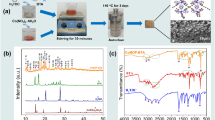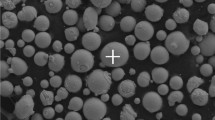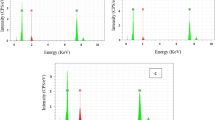Abstract
Micro-arc oxidation (MAO) is an efficient approach to improve the hardness, wear resistance, and other properties of aluminum alloys. In order to investigate the effect of the electrolyte concentration on the properties of MAO coatings for LY12 alloy, the voltage variation during the MAO process was recorded. The surface morphologies and phase compositions of the coatings produced with different electrolytes were investigated using scanning electron microscopy and X-ray diffraction, respectively. The roughness and thickness of the coatings were measured using a pocket roughness meter and an eddy-current thickness meter, respectively. The tribological performances of the coatings were investigated against GCr15 bearing steel on a ball-on-disc wear tester in open air. The results showed that with an increase in the Na2SiO3 content, the working voltage of the MAO process decreased, the roughness and thickness of the coatings increased significantly, and the relative content of the α-Al2O3 phase decreased. With an increase in the KOH content, the working voltage decreased slightly, the roughness and thickness of the coatings increased slightly, and the α-and γ-Al2O3 phase contents remained unchanged. The friction coefficient and wear rate of the coatings increased with an increase in the Na2SiO3 and KOH concentrations. A decrease in the porosity and roughness and an increase in the α-Al2O3 content of the coatings reduced their wear mass loss.

Similar content being viewed by others
References
Buldum B B, Bayhan B. Effect of ball-burnishing parameters on surface roughness and surface hardness of aluminum alloy 6013. Materials Testing, 2018, 60(4): 418–422
Miller W S, Zhuang L, Bottema J, Wittebrood A J, De Smet P, Haszler A, Vieregge A. Recent development in aluminium alloys for the automotive industry. Materials Science and Engineering A, 2000, 280(1): 37–49
Nie X, Meletis E I, Jiang J C, Leyland A, Yerokhin A L, Matthews A. Abrasive wear/corrosion properties and TEM analysis of Al2O3 coatings fabricated using plasma electrolysis. Surface and Coatings Technology, 2002, 149(2–3): 245–251
Yang X, Chen L, Jin X Y, Du J C, Xue W B. Influence of temperature on tribological properties of microarc oxidation coating on 7075 aluminium alloy at 25°C–300°C. Ceramics International, 2019, 45(9): 12312–12318
Lv X C, Cao L, Wan Y, Xu T W. Effect of different electrolytes in micro-arc oxidation on corrosion and tribological performance of 7075 aluminum alloy. Materials Research Express, 2019, 6(8): 086421
Yilmaz M S, Sahin O. Applying high voltage cathodic pulse with various pulse durations on aluminium via micro-arc oxidation (MAO). Surface and Coatings Technology, 2018, 347: 278–285
Gu Y, Ma H, Yue W, Tian B, Chen L L, Mao D. Microstructure and corrosion model of MAO coating on nano grained AA2024 pretreated by ultrasonic cold forging technology. Journal of Alloys and Compounds, 2016, 681: 120–127
Nasiri-Vatan H, Ebrahimi-Kahrizsangi R, Asgarani M K. Tribological performance of PEO-WC nanocomposite coating on Mg alloys deposited by plasma electrolytic oxidation. Tribology International, 2016, 98: 253–260
Yavari S A, Necula B S, Fratila-Apachitei L E, Duszczyk J, Apachitei I. Biofunctional surfaces by plasma electrolytic oxidation on titanium biomedical alloys. Surface Engineering, 2016, 32(6): 411–417
Yu S R, Yao Q, Chu H C. Morphology and phase composition of MAO ceramic coating containing Cu on Ti6Al4V alloy. Rare Metals, 2017, 36(8): 671–675
Marques I S V, Alfaro M F, Cruz N C, Mesquita M F, Takoudis C, Sukotjo C, Mathew M T, Barão V A R. Tribocorrosion behavior of biofunctional titanium oxide films produced by micro-arc oxidation: Synergism and mechanisms. Journal of the Mechanical Behavior of Biomedical Materials, 2016, 60: 8–21
Sarbishei S, Faghihi Sani M A, Mohammadi M R. Effects of alumina nanoparticles concentration on microstructure and corrosion behavior of coatings formed on titanium substrate via PEO process. Ceramics International, 2016, 42(7): 8789–8797
Izmir M, Ercan B. Anodization of titanium alloys for orthopedic applications. Frontiers of Chemical Science and Engineering, 2019, 13(1): 28–45
Li J X, Zhang Y M, Han Y, Zhao Y M. Effects of micro-arc oxidation on bond strength of titanium to porcelain. Surface and Coatings Technology, 2010, 204(8): 1252–1258
Lu Z, Ouyang Z, Grant N, Wan Y M, Yan D, Lennon A. Manipulation of stored charge in anodic aluminium oxide/SiO2 dielectric stacks by the use of pulsed anodisation. Applied Surface Science, 2016, 363: 296–302
Tian J, Luo Z Z, Qi S K, Sun X J. Structure and antiwearbehaviorof micro-arc oxidized coatings on aluminum alloy. Surface and Coatings Technology, 2002, 154(1): 1–7
Xin S G, Song L X, Zhao R G, Hu X F. Properties of aluminium oxide coating on aluminium alloy produced by micro-arc oxidation. Surface and Coatings Technology, 2005, 199(2–3): 184–188
Rehman Z U, Lee D G, Koo B H. Effect of OH- concentration on the mechanical and microstructural properties of microarc oxidatoin coating produced on Al7075 alloy. Korean Journal of Materials Research, 2015, 25(10): 503–508
Polat A, Makaraci M, Usta M. Influence of sodium silicate concentration on structural and tribological properties of microarc oxidation coatings on 2017A aluminum alloy substrate. Journal of Alloys and Compounds, 2010, 504(2): 519–526
Zheng H, Wang Y, Li B, Han G R. The effects of Na2WO4 concentration on the properties of microarc oxidation coatings on aluminum alloy. Materials Letters, 2005, 59(2–3): 139–142
Jin F, Chu P K, Tong H, Zhao J. Improvement of surface porosity and properties of alumina films by incorporation of Fe micrograins in micro-arc oxidation. Applied Surface Science, 2006, 253(2): 863–868
Tseng C C, Lee J L, Kuo T H, Kuo S N, Tseng K H. The influence of sodium tungstate concentration and anodizing conditions on microarc oxidation (MAO) coatings for aluminum alloy. Surface and Coatings Technology, 2012, 206(16): 3437–3443
Wang P, Wu T, Peng H, Yang G X. Effect of NaAlO2 concentrations on the properties of micro-arc oxidation coatings on pure titanium. Materials Letters, 2016, 170: 171–174
Zong Y, Song R G, Hua T S, Cai S W, Wang C, Li H. Effects of current frequency on the MAO coatings on AA7050. Surface Engineering, 2019: 1–8
Barati N, Meletis E I, Golestani Fard F, Yerokhin A, Rastegari S, Al Faghihi-Sani M A. Al2O3-ZrO2 nanostructured coatings using DC plasma electrolyticoxidation to improve tribological properties of Al substrates. Applied Surface Science, 2015, 356: 927–934
Weng Y C, Liu H X, Ji S P, Huang Q, Wu H, Li Z B, Wu Z Z, Wang H Y, Tong L P, Fu R K Y, Chu P K, Pan F. A promising orthopedic implant material with enhanced osteogenic and antibacterial activity: Al2O3-coated aluminum alloy. Applied Surface Science, 2018, 457: 1025–1034
Lv G, Gu W, Chen H, Feng W R, Khosa M L, Li L, Niu E W, Zhang G L, Yang S Z. Characteristic of ceramic coatings on aluminum by plasma electrolytic oxidation in silicate and phosphate electrolyte. Applied Surface Science, 2006, 253(5): 2947–2952
Zhuang J J, Guo Y Q, Xiang N, Lu X Y, Hu Q, Song R G. Sliding wear behaviour and microstructure of PEO coatings formed on aluminium alloy. Materials Science and Technology, 2016, 32(15): 1559–1566
Acknowledgements
This work was supported by the China Postdoctoral Science Foundation Funded Project (No. 2016M602668), the Fundamental Research Funds for the Central Universities of University of Electronic Science and Technology of China (No. ZYGX2015J029), the Project of the Science and Technology Department in Sichuan Province Supporting Plan (No. 2016JQ0022) and the National Natural Science Foundation of China (Grant No. 51501156).
Author information
Authors and Affiliations
Corresponding author
Rights and permissions
About this article
Cite this article
Wang, C., Chen, J., He, J. et al. Effect of electrolyte concentration on the tribological performance of MAO coatings on aluminum alloys. Front. Chem. Sci. Eng. 14, 1065–1071 (2020). https://doi.org/10.1007/s11705-019-1909-x
Received:
Accepted:
Published:
Issue Date:
DOI: https://doi.org/10.1007/s11705-019-1909-x




